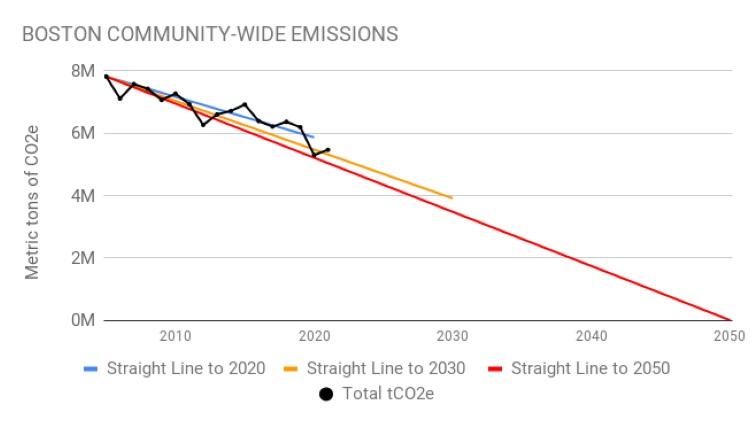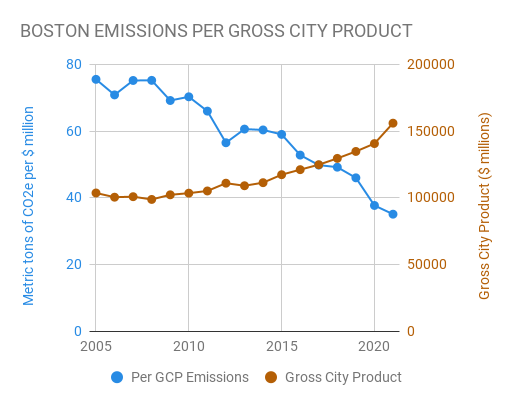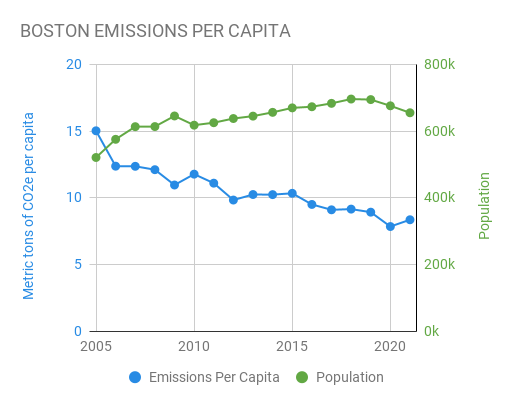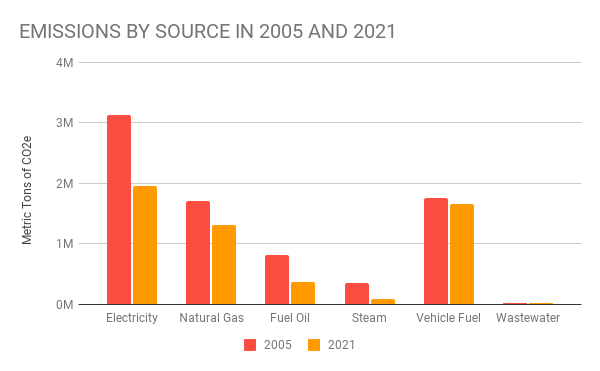Boston's Carbon Emissions
Explore Boston's community and municipal greenhouse gas inventories.
Overview
Read through the inventory report and methodology.
Economic and Population Growth
The reduction in Boston’s emissions has occurred at the same time that the population and the number of jobs in Boston have increased. The Boston community has grown from 521 thousand residents in 2005 to more than 654 thousand in 2021. Emissions per resident over the same time period have decreased 44%, from 15 to 8 metric tons per year. Boston’s economic growth, as measured by Gross City Product (GCP), has increased from 106 billion dollars to 156 billion. Emissions per million dollars of GCP have decreased 54%, from 76 to 35 metric tons per million dollars.
Community-wide emissions
Community emissionsMayor Michelle Wu has committed to achieving a Green New Deal for Boston, by tackling the climate crisis with strategies that address economic, social, and racial inequities. Eliminating greenhouse gas emissions that drive climate change is core to the vision, along with building resilience to a changing climate, and underpin Boston’s Climate Action Plan. To measure progress, Boston follows the Global Protocol for Community-Scale Greenhouse Gas Emission Inventories (GPC). The baseline year is 2005, the first year in which consistent and reliable data was collected. Boston has achieved its interim goal of reducing citywide emissions by 25% by 2020, and has a goal to achieve a 50% reduction by 2030.
The annual greenhouse gas (GHG) inventory is based on a combination of direct data and estimates for data that cannot be obtained directly. Data sources include City records, utility company reports, and information from state and federal agencies. Reporting is separated into community-wide and local government operations inventories. Because the data for these inventories is collected using separate protocols on separate timescales, the Local Government Operations Inventory should be considered to be overlapping, but not completely contained within the Community Inventory.
What's included?
- Energy used by buildings and other stationary sources; fugitive emissions from methane distribution within Boston limits.
- On-road and some off-road transportation, and public transportation trips within city limits.
- Wastewater treatment within city limits.
What's not?
- Emissions generated outside the city boundary to produce goods or services used by residents (for example, emissions from food produced elsewhere but consumed by Bostonians, or airplane emissions that cannot be attributed specifically to Boston).
Boston will continue to evaluate the benefits and challenges of “consumption-based” emissions accounting as a complement to the current inventory methodology.
The goal of the community inventory is to include GHG emissions associated with all activities — residential, commercial/industrial, institutional, transportation-related — within the administrative boundary of the City of Boston. The Boston community-wide inventory accounts for emissions from the following sources:
- Stationary energy use from residents, businesses and other activities, including municipal buildings.
- On-road and off-road transportation, including municipal vehicle fleet fuel use (airplane travel at Logan airport excluded).
- Solid waste and wastewater disposal and treatment.
In Boston, energy use in stationary sources dominates, accounting for 68% of total emissions (3.6 MtCO2e). Commercial, industrial, and large residential buildings generated 47% of emissions (2.5 MtCO2e), while small residential buildings accounted for 21% of emissions (1.1 MtCO2e). Fugitive gas emissions for all sectors account for less than 1% (20 thousand tCO2e) of emissions. Emissions in the building sector stem from the use of electricity (52%), natural gas (or methane gas) (35%), fuel oil (10%), and steam (3%).
Individual buildings over 20,000 square feet publicly report their energy and water usage annually. The data is available at: Analyze Boston.
- Commercial, industrial and large residential buildings, including high-rise offices, hospitals, universities and research buildings, manufacturing, and construction
- Small residential buildings
- Fugitive emissions from oil and natural gas (or methane gas) systems
Emissions from transportation comprise 31% of the inventory (1.7 MtCO2e). This is lower than transportation’s share of statewide or national emissions because of Boston’s density and robust public transportation system. More than half of Bostonians get to work via a mode other than a car (Go Boston 2030).
The inventory captures the emissions from the estimated Vehicle Miles Traveled (VMT) inside the City, plus public transportation and off-road vehicles used at the airport and wastewater treatment plant. Primary energy sources include gasoline (76%), diesel (20%), natural gas (or methane gas) (1%), electricity (2%), biodiesel and propane combined (<1%).
GHGs reported in the waste sector refer to emissions from wastewater treatment only and account for less than 1% of total emissions (19 thousand tCO2e). All, or almost all, of Boston’s solid waste is sent to Waste To Energy (WTE) incineration plants that feed the electricity grid, so emissions are counted as part of regional electricity generation. Boston has a Zero Waste initiative and the indirect accounting of emissions from solid waste in our GHG inventory does not affect the City’s commitment to waste reduction.
The Carbon Free Boston analysis estimated that Boston’s waste sector accounted 393 thousand tons of direct carbon emissions in 2017, if the WTE emissions are broken out from the electricity emissions factor. The Zero Waste Boston initiative has issued strategies to reduce, reuse, recycle and compost at least 80 to 90 percent of Boston’s solid waste. The Carbon Free Boston analysis determined that a 90 percent diversion rate would reduce waste emissions by 78% relative to 2017 emissions, including the WTE emissions.
short-term changes
From 2019 to 2021, the community’s GHG emissions decreased nearly 13% (174 thousand tCO2e), reflecting the impacts of the COVID-19 pandemic:
- The commercial sector used significantly less natural gas (or methane gas) and electricity.
- The residential sector used slightly more electricity and oil; 2021 had more cooling degree days than 2019.
- However, Boston residents, businesses and institutions used 2% less natural gas (or methane gas) than in 2018. The 2019-20 winter was slightly warmer than the 2018-19 winter.
- Transportation emissions decreased due to an 18% decrease in vehicle miles traveled (VMT) between 2019 and 2020. VMT increased again by 12% between 2020 and 2021, but has not reached pre-pandemic levels.
LONG-TERM CHANGES
Boston’s GHG emissions from 2005 to 2021 have declined by 30%. Prior to the COVID-19 pandemic, about half of the reduction had been due to state-level and regional action to clean the New England electric grid. As a result, the electricity emissions factor had improved continuously over time, as electricity had become less carbon-intensive. Following the COVID-19 pandemic, only 36% of the reduction is due to a lower electric emissions factor, whereas 35% is due to reduced fossil fuel use (fuel oil and natural gas, or methane gas), 12% due to reduced electricity use and 2% due to reduced steam use. While VMT have increased since 2005, the impact of increased traffic has been counteracted by improved fuel economy, as the average vehicle registered in Massachusetts has improved from 18.6 miles per gallon (mpg) in 2005 to an estimated 23.4 mpg in 2021.
The energy efficiency efforts of the City’s programs, Boston’s utilities, local government and many businesses, institutions, and residents have also offset much of Boston’s recent growth. The City has also adopted additional policies and programs to decrease our emissions, such as the Building Emissions Reduction and Disclosure Ordinance or the ZEV Roadmap.
The inventory employs measured data, projections, models, and, where data is scarce, best estimates. All of these sources have some level of uncertainty, most of which have not been quantified. Furthermore, the inventory is frequently revised as new and better data become available, models are improved, new methodology is developed, and international standards evolve. For these reasons, longer term trends are likely more reliable than absolute numbers or year-to-year changes.
Municipal emissions
Municipal emissionsThe Local Government Operations (LGO) inventory calculates all greenhouse gas emissions generated by municipal operations in the City of Boston. This includes the burning of fuels in the City’s facilities, vehicles, and other equipment, and the energy used in municipal buildings, vehicles, parks, street lights, and traffic signals. The LGO inventory is based on the ICLEI greenhouse gas reporting protocol for local government operations.
Under the protocol, emissions that are not under the operational control of the City government or involve leased properties are excluded. Emissions from the Boston Housing Authority, the Massachusetts Water Resources Authority (MWRA), and the Boston Planning and Development Agency (BPDA) are not included in the inventory. Those from the Boston Public Health Commission (BPHC) and the Boston Water and Sewer Commission (BWSC) are.
While the timeframe for the citywide inventory is the calendar year, the LGO inventory is conducted on the fiscal year, from July to June. Because the data for these inventories is collected using separate protocols and on different timescales, the LGO should be considered to be largely overlapping but not completely contained within the Citywide inventory.
In FY2021, emissions from local government operations, or municipal emissions, had decreased by 38% from 2005. Previously, the City of Boston had purchased Green-e certified RECs, but ceased the practice in 2019; in FY2019, we purchased RECs equal to approximately one fourth of our total electricity consumption. In Fiscal Year 2023, the City evaluated options for a direct investment in renewable energy. The City of Boston met its municipal 2020 goal of a 25% reduction 5 years ahead of schedule.
Boston’s LGO emissions are dominated by building energy consumption. Electricity and gas consumption by buildings each make up about one third of total GHG emissions. Transportation fuels, diesel and gasoline, together make up one fourth of total municipal GHG emissions.
Similar to the community-wide inventory, Boston’s municipal operations GHG inventory trends are driven by a number of external and internal factors. Diesel consumption is continuing to decrease as Boston Public Schools switches its fleets from diesel- to propane-powered school buses. The continued downward trend in the regional electric grid emissions rate also contributed to reduced emissions.
As the department with the largest building portfolio and the second largest vehicle inventory (after Boston Police Department), Boston Public Schools (BPS) represent the largest source of municipal emissions. BPS owns and operates approximately 11 million of the City’s 16.5 million square feet of building space across the roughly 127 school buildings in the district. These buildings represent over a third of municipal electricity consumption and two thirds of municipal natural gas (or methane gas) consumption.
The BPS Department of Transportation (DOT) fleet includes over 700 school buses and uses 73% of all the diesel fuel consumed by municipal government. BPS has continued their replacement of the oldest, dirtiest diesel buses to lower emissions propane engines; propane buses represented more than half of the fleet by 2020. In 2022, BPS-DOT announced a new goal of full fleet electrification by 2030, and will pilot 20 electric school buses during the 2022/2023 school year; the impact of electric buses will begin to be reflected in the FY23 emissions inventory.
The next largest source of GHG emission from municipal operation is the Public Works Department’s street lighting inventory. The 66,000 electric street lights and the 2,800 natural gas (or methane gas) street lights (found in Boston’s historic districts) account for 10.7% of total municipal GHG emissions. Street lighting used to make up a much larger share of Boston’s municipal GHG profile; however, aggressive conversions of electric street lights to LEDs dating back to 2010 have cut emissions from street lights in half. While gas lamps comprise just 5% of total street light fixtures, they produce 36% of GHG emissions from street lights. In 2022, Boston piloted a new LED lamp designed to look identical to gas street lamps in Bay Village, as part of a plan to electrify gas lamps
The third largest source of GHG emissions from municipal operations is the Boston Police Department (BPD) at about 9.8% of total municipal emissions. In FY20, BPD operated approximately 660,000 square feet of building area and managed a fleet of over 1,000 vehicles. These buildings accounted for 7% of electricity and 4% of natural gas (or methane gas) consumed by City of Boston departments. The BPD fleet accounted for roughly 56% of all gasoline consumed by City of Boston vehicles in FY20
- The electricity emissions factor has decreased since 2005 as described in the community inventory.
- Emissions from natural gas (or methane gas) and fuel oil use have decreased since FY05 as the City converted older buildings from oil to gas, and opened new, energy-efficient buildings that use natural gas or electricity for heat and hot water.
- Fuel oil use has reduced due to the closure of the Boston Public Health Commission’s Long Island facility, which relied primarily on fuel oil for heating.
- Electricity use has decreased over the long term, primarily driven by the near complete conversion of Boston’s 66,000 electric streetlights to more efficient LED fixtures. Boston has also invested in building energy efficiency measures on a project-by-project basis, and is engaging in deeper energy efficiency retrofits as part of the Renew Boston Trust.
- Steam use has decreased over the long term due to the reduction in steam use at City Hall and Copley Library and the conversion of the West End Branch library from steam to gas.
- BPS has shifted over half the bus fleet from diesel to propane and adopted a new goal of full fleet electrification by 2030. Propane buses offer a slight carbon benefit and reduce nitrogen dioxide (NOx) emissions by up to 95% compared to diesel, delivering significant air quality benefits.
Inventory methodologies
MethodologyThe City of Boston is party to the Global Covenant of Mayors (GCoM), which requires the City to follow the Global Protocol for Community-Scale Greenhouse Gas Emission Inventories (GPC). Boston utilizes the GPC framework and publishes a full methodology to share our inventory approach.
- Learn more about the GHG Protocol for Cities
- Boston Greenhouse Gas Inventory Methodology (last revised in August 2023)
Boston’s GHG inventories are reported in CO2 equivalents (or CO2e), a universal unit of measurement that accounts for the global warming potential (GWP) of different greenhouse gasses. Boston’s inventory includes carbon dioxide (CO2), natural gas (CH4), and nitrous oxide (N2O), and uses Global Warming Potentials (GWPs) from the latest version of the International Panel on Climate Change (IPCC) Guidelines (currently 5AR). The formula used to determine the CO2e from a given energy use is Activity Data x Emissions Factor1+2+3 = GHG Emissions from Activity,
Boston currently is choosing to report at the GCP BASIC level, which covers scope 1 and scope 2 emissions from stationary and transportation sources, as well as scope 1 and scope 3 emissions from waste.
- Scope 1: GHG emissions from sources located within the City boundary.
- Scope 2: GHG emissions occurring as a consequence of the use of grid-supplied electricity, heat, steam, and cooling within the City boundary.
- Scope 3: All other emissions that occur outside the City boundary as a result of activities taking place within the city boundary.
2020-2021 data revisions
- The City revised its methodology regarding the steam emissions factor. Previously, all emissions associated with steam brought into the City from the Kendall cogeneration plant were associated with the electricity generated by the cogeneration process, with no emissions associated with the steam generated, treated as a byproduct. The emissions factor has since been updated to account for emissions associated with steam production by allocating a portion of the plant’s emissions to steam production using the efficiency method. The methodology change is further detailed later in the methodology document that may be accessed on our website. The change in methodology took effect for the 2020 and 2021 inventories, and was applied to 2018 and 2019 inventories. Insufficient data is available to make the change in methodology retroactive to 2005.
- The Census Bureau did not release its standard 2020 American Community Survey 1-year estimates because of the impacts of the COVID-19 pandemic. As a result, we used the 2019 number of households with heating oil as a placeholder for the 2020 inventory. The 2021 ACS 1-year estimate was used for the 2021 inventory.
- MBTA data is largely reported based on the fiscal year rather than the calendar year.
We will continue to develop methodological updates to improve consistency across City policies and reporting frameworks.
The Local Government Operations inventory methodology for calculating GHG emissions is based on the ICLEI greenhouse gas reporting protocol for local government operations, developed by ICLEI and the National Association of Clean Air Agencies. The protocol categorizes emissions as direct (Scope 1) or indirect (Scope 2). Direct emissions come from the burning of natural gas (or methane gas), fuel oil, gasoline, diesel fuel, and other fuels in the City’s facilities, vehicles, and other equipment. Indirect emissions come from the burning of fuels in facilities owned and operated by others to produce electricity, and steam that the City uses. Emissions that are not under the operational control of the City government, or involve leased properties, are excluded. Emissions from the Boston Housing Authority, the Massachusetts Water Resources Authority (MWRA), and the Boston Planning and Development Agency (BPDA) are not included in the inventory. Those from the Boston Public Health Commission (BPHC), and the Boston Water and Sewer Commission (BWSC) are.
In 2013, the City invested in an Enterprise Energy Management System (EEMS) and an Energy Manager to track and report local government energy consumption, cost, and GHG emissions. Prior years’ reporting relied on annual data collection from numerous stakeholders in the auditing, budget, and purchasing offices. This manual process sometimes led to inconsistent data collection from year to year. Now the process is almost entirely automated, and with complete invoice data for over seven calendar years entered, the City can track progress towards energy and GHG reduction goals on a monthly basis. By tracking this data more closely, the City is able to identify which departments, buildings or assets are contributing most to our overall portfolio, and in the process, has identified errors in utility bills worth over $1.2 million in credits back to the City.


















